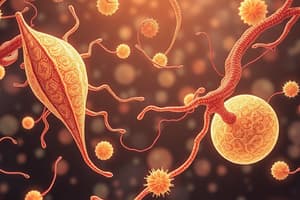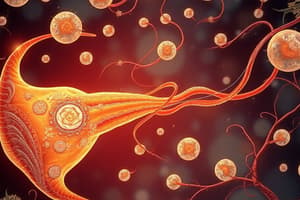Podcast
Questions and Answers
How does the blood-testis barrier contribute to successful spermatogenesis?
How does the blood-testis barrier contribute to successful spermatogenesis?
It protects the developing sperm cells from the immune system, preventing autoimmune reactions that could damage or destroy them.
Explain the roles of both Luteinizing Hormone (LH) and Follicle-Stimulating Hormone (FSH) in the process of spermatogenesis.
Explain the roles of both Luteinizing Hormone (LH) and Follicle-Stimulating Hormone (FSH) in the process of spermatogenesis.
LH stimulates the Leydig cells to produce testosterone which promotes spermatogenesis. FSH stimulates Sertoli cells which support and nourish the developing sperm cells.
Describe the role of Sertoli cells in regulating spermatogenesis via a negative feedback loop.
Describe the role of Sertoli cells in regulating spermatogenesis via a negative feedback loop.
Sertoli cells produce inhibin, which inhibits FSH secretion by the pituitary gland. This reduces stimulation of the Sertoli cells when sperm production is high.
How might exposure to toxins or radiation affect male fertility, and through what mechanism(s)?
How might exposure to toxins or radiation affect male fertility, and through what mechanism(s)?
Briefly describe how Assisted Reproductive Technologies (ART) like IVF or ICSI can help overcome male infertility issues related to spermatogenesis.
Briefly describe how Assisted Reproductive Technologies (ART) like IVF or ICSI can help overcome male infertility issues related to spermatogenesis.
How does the process of crossing over during meiosis I contribute to genetic diversity in sperm cells?
How does the process of crossing over during meiosis I contribute to genetic diversity in sperm cells?
Describe the role of type A and type B spermatogonia in the mitotic phase of spermatogenesis.
Describe the role of type A and type B spermatogonia in the mitotic phase of spermatogenesis.
Explain the significance of the acrosome reaction during fertilization and how spermiogenesis contributes to this process.
Explain the significance of the acrosome reaction during fertilization and how spermiogenesis contributes to this process.
What are the key morphological changes that spermatids undergo during spermiogenesis to become spermatozoa?
What are the key morphological changes that spermatids undergo during spermiogenesis to become spermatozoa?
Explain the roles of both testosterone and FSH in regulating spermatogenesis. How do their functions differ?
Explain the roles of both testosterone and FSH in regulating spermatogenesis. How do their functions differ?
If spermiogenesis was interrupted, but meiosis was not, what key structures of the spermatozoa would be missing, or not fully functional?
If spermiogenesis was interrupted, but meiosis was not, what key structures of the spermatozoa would be missing, or not fully functional?
How does the location of spermatogonia within the seminiferous tubules relate to their function in spermatogenesis?
How does the location of spermatogonia within the seminiferous tubules relate to their function in spermatogenesis?
Describe the structural components of a mature spermatozoa and their respective functions in fertilization.
Describe the structural components of a mature spermatozoa and their respective functions in fertilization.
Flashcards
Luteinizing Hormone (LH)
Luteinizing Hormone (LH)
Stimulates Leydig cells in the testes to produce testosterone.
Testosterone's Role
Testosterone's Role
Promotes spermatogenesis and development of male secondary sexual characteristics.
FSH Function
FSH Function
Stimulates Sertoli cells to support and nourish developing sperm cells.
Sertoli Cells
Sertoli Cells
Signup and view all the flashcards
Factors Affecting Spermatogenesis
Factors Affecting Spermatogenesis
Signup and view all the flashcards
Spermatogenesis
Spermatogenesis
Signup and view all the flashcards
Mitosis in Spermatogenesis
Mitosis in Spermatogenesis
Signup and view all the flashcards
Meiosis in Spermatogenesis
Meiosis in Spermatogenesis
Signup and view all the flashcards
Spermiogenesis
Spermiogenesis
Signup and view all the flashcards
Spermatogonia
Spermatogonia
Signup and view all the flashcards
Acrosome Function
Acrosome Function
Signup and view all the flashcards
Sperm Tail (Flagellum)
Sperm Tail (Flagellum)
Signup and view all the flashcards
Testosterone & FSH
Testosterone & FSH
Signup and view all the flashcards
Study Notes
- Spermatogenesis is the process of sperm cell development.
- It occurs in the seminiferous tubules of the testes.
- Spermatogenesis involves mitosis, meiosis, and spermiogenesis.
- The entire process takes approximately 64-72 days in humans.
- It is regulated by hormones, including testosterone and follicle-stimulating hormone (FSH).
Stages of Spermatogenesis
- Spermatogenesis can be divided into three main phases: mitosis, meiosis, and spermiogenesis.
- Mitosis involves the division of spermatogonia to produce more spermatogonia and primary spermatocytes.
- Meiosis involves two rounds of cell division (meiosis I and meiosis II) to reduce the chromosome number from diploid to haploid.
- Spermiogenesis is the final stage, where spermatids differentiate into spermatozoa (sperm cells).
Mitosis
- Spermatogonia are diploid stem cells located in the seminiferous tubules.
- Type A spermatogonia divide by mitosis to produce more type A spermatogonia or type B spermatogonia.
- Type B spermatogonia divide by mitosis to form primary spermatocytes.
Meiosis I
- Primary spermatocytes are diploid cells that enter meiosis I.
- During meiosis I, homologous chromosomes pair up and exchange genetic material through crossing over.
- This process increases genetic diversity in sperm cells.
- At the end of meiosis I, each primary spermatocyte divides into two haploid secondary spermatocytes.
Meiosis II
- Secondary spermatocytes are haploid cells that enter meiosis II.
- During meiosis II, the sister chromatids separate, resulting in the formation of two haploid spermatids from each secondary spermatocyte.
Spermiogenesis
- Spermatids are haploid cells that undergo a series of morphological changes to become spermatozoa.
- Spermiogenesis involves the formation of the acrosome, condensation of the nucleus, development of the flagellum, and shedding of excess cytoplasm.
- The acrosome contains enzymes that help the sperm cell penetrate the egg.
- The flagellum is the tail of the sperm cell, which enables it to swim.
Spermatozoa (Sperm Cells)
- Spermatozoa are mature male gametes.
- They are composed of a head, midpiece, and tail.
- The head contains the nucleus and acrosome.
- The midpiece contains mitochondria that provide energy for movement.
- The tail is a flagellum that propels the sperm cell.
- Mature spermatozoa are released into the lumen of the seminiferous tubules and transported to the epididymis for storage and further maturation.
Hormonal Regulation
- Spermatogenesis is regulated by hormones, including testosterone and follicle-stimulating hormone (FSH).
- Luteinizing hormone (LH) stimulates Leydig cells in the testes to produce testosterone.
- Testosterone promotes spermatogenesis and the development of male secondary sexual characteristics.
- FSH stimulates Sertoli cells in the seminiferous tubules, which support and nourish developing sperm cells.
- Sertoli cells also produce inhibin, which inhibits FSH secretion by the pituitary gland, providing negative feedback control of spermatogenesis.
Sertoli Cells
- Sertoli cells are somatic cells located in the seminiferous tubules.
- They provide structural and nutritional support to developing sperm cells.
- Sertoli cells form tight junctions that create the blood-testis barrier, which protects developing sperm cells from the immune system.
- They secrete various factors that regulate spermatogenesis, including androgen-binding protein (ABP), which concentrates testosterone in the seminiferous tubules.
Factors Affecting Spermatogenesis
- Several factors can affect spermatogenesis, including:
- Genetic abnormalities
- Hormonal imbalances
- Exposure to toxins or radiation
- Infections
- Heat stress
- These factors can lead to impaired sperm production or function, resulting in infertility.
Clinical Significance
- Understanding spermatogenesis is important for diagnosing and treating male infertility.
- Semen analysis is a common test used to evaluate sperm count, motility, and morphology.
- Assisted reproductive technologies (ART), such as in vitro fertilization (IVF) and intracytoplasmic sperm injection (ICSI), can be used to overcome male infertility.
Studying That Suits You
Use AI to generate personalized quizzes and flashcards to suit your learning preferences.




